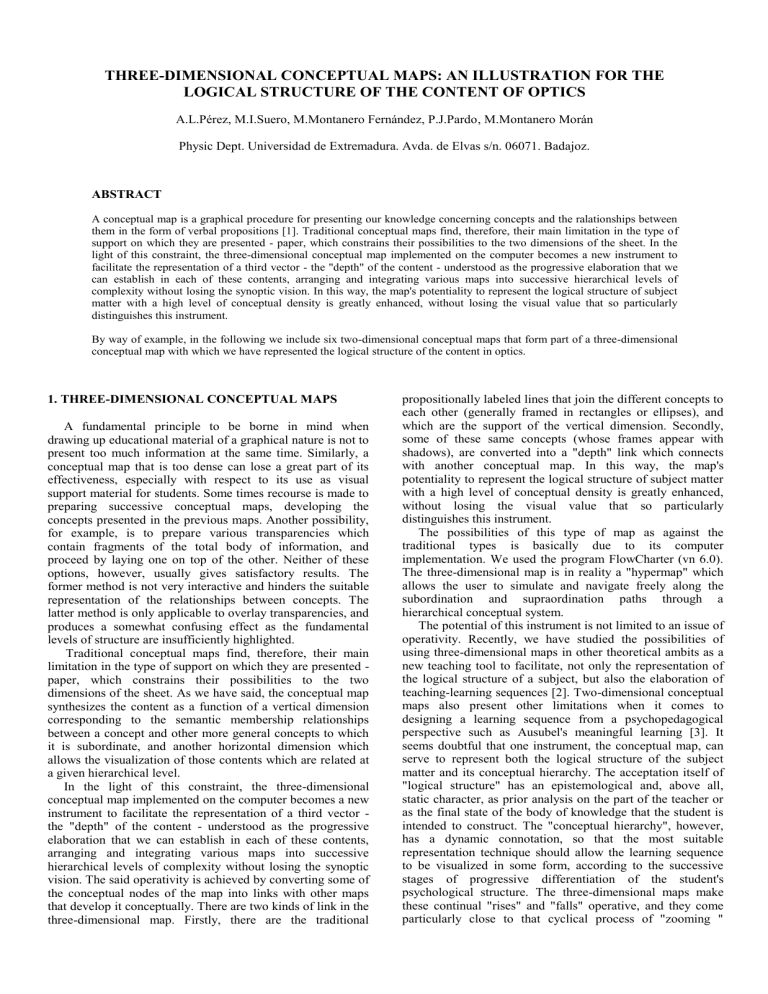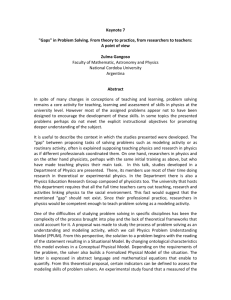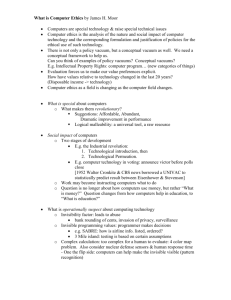THREE DIMENSIONAL CONCEPTUAL MAPS OF OPTICS

THREE-DIMENSIONAL CONCEPTUAL MAPS: AN ILLUSTRATION FOR THE
LOGICAL STRUCTURE OF THE CONTENT OF OPTICS
A.L.Pérez, M.I.Suero, M.Montanero Fernández, P.J.Pardo, M.Montanero Morán
Physic Dept. Universidad de Extremadura. Avda. de Elvas s/n. 06071. Badajoz.
ABSTRACT
A conceptual map is a graphical procedure for presenting our knowledge concerning concepts and the ralationships between them in the form of verbal propositions [1]. Traditional conceptual maps find, therefore, their main limitation in the type of support on which they are presented - paper, which constrains their possibilities to the two dimensions of the sheet. In the light of this constraint, the three-dimensional conceptual map implemented on the computer becomes a new instrument to facilitate the representation of a third vector - the "depth" of the content - understood as the progressive elaboration that we can establish in each of these contents, arranging and integrating various maps into successive hierarchical levels of complexity without losing the synoptic vision. In this way, the map's potentiality to represent the logical structure of subject matter with a high level of conceptual density is greatly enhanced, without losing the visual value that so particularly distinguishes this instrument.
By way of example, in the following we include six two-dimensional conceptual maps that form part of a three-dimensional conceptual map with which we have represented the logical structure of the content in optics.
1. THREE-DIMENSIONAL CONCEPTUAL MAPS
A fundamental principle to be borne in mind when drawing up educational material of a graphical nature is not to present too much information at the same time. Similarly, a conceptual map that is too dense can lose a great part of its effectiveness, especially with respect to its use as visual support material for students. Some times recourse is made to preparing successive conceptual maps, developing the concepts presented in the previous maps. Another possibility, for example, is to prepare various transparencies which contain fragments of the total body of information, and proceed by laying one on top of the other. Neither of these options, however, usually gives satisfactory results. The former method is not very interactive and hinders the suitable representation of the relationships between concepts. The latter method is only applicable to overlay transparencies, and produces a somewhat confusing effect as the fundamental levels of structure are insufficiently highlighted.
Traditional conceptual maps find, therefore, their main limitation in the type of support on which they are presented - paper, which constrains their possibilities to the two dimensions of the sheet. As we have said, the conceptual map synthesizes the content as a function of a vertical dimension corresponding to the semantic membership relationships between a concept and other more general concepts to which it is subordinate, and another horizontal dimension which allows the visualization of those contents which are related at a given hierarchical level.
In the light of this constraint, the three-dimensional conceptual map implemented on the computer becomes a new instrument to facilitate the representation of a third vector - the "depth" of the content - understood as the progressive elaboration that we can establish in each of these contents, arranging and integrating various maps into successive hierarchical levels of complexity without losing the synoptic vision. The said operativity is achieved by converting some of the conceptual nodes of the map into links with other maps that develop it conceptually. There are two kinds of link in the three-dimensional map. Firstly, there are the traditional propositionally labeled lines that join the different concepts to each other (generally framed in rectangles or ellipses), and which are the support of the vertical dimension. Secondly, some of these same concepts (whose frames appear with shadows), are converted into a "depth" link which connects with another conceptual map. In this way, the map's potentiality to represent the logical structure of subject matter with a high level of conceptual density is greatly enhanced, without losing the visual value that so particularly distinguishes this instrument.
The possibilities of this type of map as against the traditional types is basically due to its computer implementation. We used the program FlowCharter (vn 6.0).
The three-dimensional map is in reality a "hypermap" which allows the user to simulate and navigate freely along the subordination and supraordination paths through a hierarchical conceptual system.
The potential of this instrument is not limited to an issue of operativity. Recently, we have studied the possibilities of using three-dimensional maps in other theoretical ambits as a new teaching tool to facilitate, not only the representation of the logical structure of a subject, but also the elaboration of teaching-learning sequences [2]. Two-dimensional conceptual maps also present other limitations when it comes to designing a learning sequence from a psychopedagogical perspective such as Ausubel's meaningful learning [3]. It seems doubtful that one instrument, the conceptual map, can serve to represent both the logical structure of the subject matter and its conceptual hierarchy. The acceptation itself of
"logical structure" has an epistemological and, above all, static character, as prior analysis on the part of the teacher or as the final state of the body of knowledge that the student is intended to construct. The "conceptual hierarchy", however, has a dynamic connotation, so that the most suitable representation technique should allow the learning sequence to be visualized in some form, according to the successive stages of progressive differentiation of the student's psychological structure. The three-dimensional maps make these continual "rises" and "falls" operative, and they come particularly close to that cyclical process of "zooming "
through the different levels of elaboration which is the focus of another less well known, but not for that less interesting, approach: the theory of elaboration of Reigeluth & Stein
[4][5].
2. ILLUSTRATION: STRUCTURE OF THE
CONCEPTUAL CONTENT OF OPTICS
By way of example, in the following we include six two-dimensional conceptual maps that form part of a three-dimensional conceptual map with which we have represented the logical structure of the content in optics. The reader will have to imagine each of these maps on the computer screen, and by "double clicking" on a concept whose frame is shaded (i.e., has a shadow), the corresponding jump is made. This jump is always downwards, except when the double click is made on the map's most inclusive concept
(occupying the topmost position), in which case there is a return jump to the parent map.
3. ACKNOWLEDGEMENTS
OPTICS
1
1
IN MY SHADOW I CONTAIN MORE INFORMATION.
DOUBLE CLICK ON IT TO SEE.
ÁREA ÓPTICA UEX
PROYECTO CIDE
Junta de Extremadura IPR98A046
Ministerio de Educación y Cultura, 1FD97-1534-C02-02.
4. REFERENCES
1.
J. D. Novak and D.B. Gowin, Aprendiendo a aprender,
Martínez Roca, Barcelona,1988.
2.
A.L. Pérez, M.I. Suero, M. Montanero Morán and M.
Montanero Fernández, Mapas de experto tridimensionales, http://grupoorion.unex.es
, ISBN 84-
95251-35-3, Junta de Extremadura, 2000.
3. D.P. Ausubel, J.D. Novak and H. Hanesian, Educational psychology: a cognitive view . Holt, New York, 1978.
4.
C. M. Reigeluth and F.S. Stein. The elaboration theory of instruction, in C. M. Reigeluth (ed.), Instructional design theories and models: an overview of their current status .
Hillsdale, New Jersey, 1983.
5. C. M. Reigeluth and F.S. Stein. Lesson blueprints based on the elaboration theory of instruction. In C. M.
Reigeluth (ed.), Instructional theories in action. Lesson illustrating selected theories and models. Hillsdale, New
2
BEHAVIOUR by means of
GEOMETRICAL
OPTICS
OPTICS is
A BRANCH OF PHYSICS that studies
LIGHT its
NATURE by means of
ÁREA ÓPTICA UEX
PROYECTO CIDE
INTERACTION WITH
MATTER AT THE
ATOMIC SCALE by means of
PHYSICAL
OPTICS
QUANTUM
OPTICS
RADIANT
ENERGY it behaves as is
LIGHT permits
3
SEEING
PARTICLES IN
MOTION
ELECTROMAGNETIC
WAVE because it excites the sense of called
PHOTONS in each medium has
CONSTANT
SPEED
VISION of a certain
FREQUENCY
RANGE
ÁREA ÓPTICA UEX
PROYECTO CIDE
4
GEOMETRICAL OPTICS studies
ÁREA ÓPTICA UEX
PROYECTO CIDE which in a transparent and homogeneous medium as is evident from
THE BEHAVIOUR OF LIGHT
PROPAGATES IN A
STRAIGHT LINE
CHANGES
DIRECTION on what is called which when it changes medium which when it strikes a polished surface fulfilling in what is called
CHANGES
DIRECTION satisfying
THE
FORMATION
OF SHARP
SHADOWS
A
MIRROR
THE LAWS OF
REFLECTION
A
DIOPTRIC
THE LAWS OF
REFRACTION
PHYSICAL OPTICS
studies explains phenomena such as
THE WAVE NATURE
OF LIGHT
5 which as such has
A VIBRATRIONAL
FREQUENCY
DIFFRACTION which determines and, in each medium,
A WAVELENGTH A COLOUR
INTERFERENCE
POLARIZATION
ÁREA ÓPTICA UEX
PROYECTO CIDE
QUANTUM OPTICS
6 explains such phenomena as studies
THE CORPUSCULAR
NATURE OF LIGHT formed by
PHOTONS
THE COMPTON
EFFECT
THE
PHOTELECTRIC
EFFECT
INTERACTIONS
BETWEEN LIGHT
AND MATTER AT
THE ATOMIC SCALE according to the theory of
PLANCK
FLUORESCENCE AND
PHOSPHORESCENCE
ÁREA ÓPTICA UEX
PROYECTO CIDE
Figure 1. Secuence of six cards that form part of the three-dimensional conceptual map. By double-clicking on the frames with shadows one jumps from one card to another.
Jersey, 1987.





